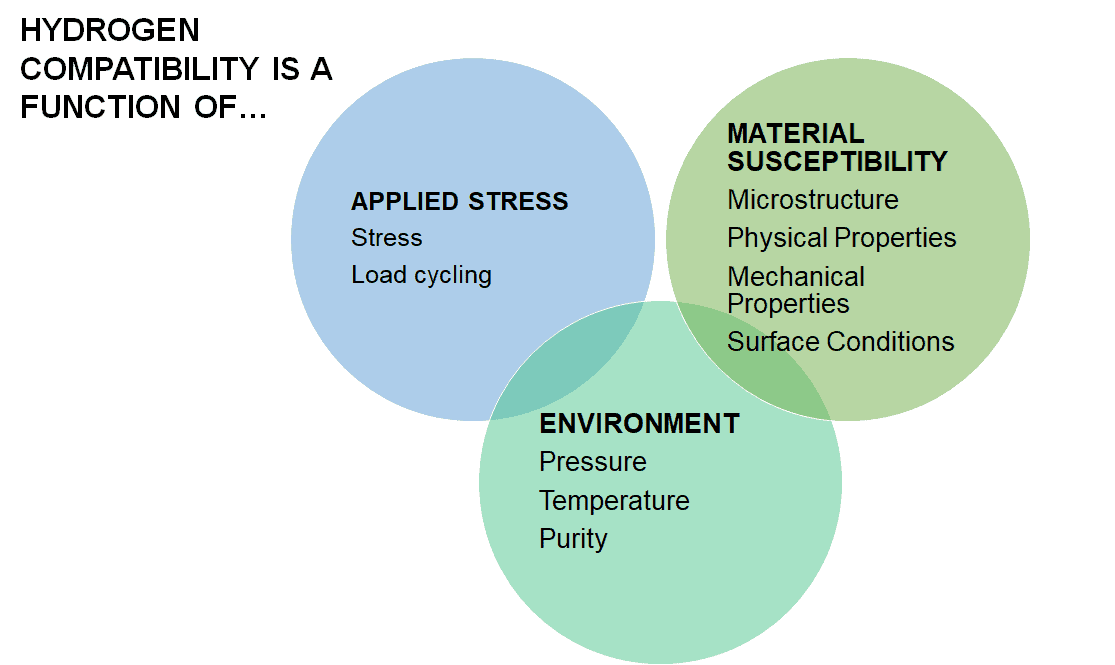
A Gas Utility’s Guide to Hydrogen Compatibility
Understanding the factors that determine how hydrogen could affect your distribution system
The shift to renewable fuels for gas is happening at lightning speed compared to the industry’s previous adoption of new technologies. There’s a lot of new information being released on a daily basis – it can be difficult to sort through all of it to identify the most relevant, reliable information and what it means for your gas utility.
Sensus is here to help. This post is part of a series on Hydrogen and Its Potential for the Gas Industry. In this series, we’ll review the fundamentals of hydrogen, discuss the impacts to natural gas utilities and your end customers, and keep you up to date on the recent hydrogen reports and policies.
_________________________________
Choosing the correct material for an application is something most of us are more familiar with than we realize. In our daily lives, we make sure not to put metal in the microwave or use plastics in the oven. These examples demonstrate the importance of considering material, application, and design. The same is true when thinking about hydrogen compatibility.
Hydrogen compatibility is the ability of a material to exhibit and maintain reliable mechanical integrity and low probability of failure, or leakage, in hydrogen applications within a risk parameter acceptable to the user. Hydrogen suitability is the ability of a component or product to perform its necessary task in hydrogen applications within the given risk parameters.
An easy way to think about these two ideas is that hydrogen compatibility is a material evaluation whereas hydrogen suitability is a component evaluation. A product might be hydrogen compatible, maintaining its mechanical integrity, but may not perform its necessary task in the hydrogen application. For example, one might have chosen the correct materials for a hydrogen storage device, but the design and application do not result in leak-free hydrogen storage. Whether a material is compatible for use in gaseous hydrogen environments depends on three main factors: stress, environment, and material susceptibility.

Material Susceptibility
When metals are exposed to hydrogen, it can lead to hydrogen embrittlement which causes a loss in tensile strength, ductility, and facture toughness (Material Compatibility | Hydrogen Tools, n.d.). Hydrogen embrittlement results from hydrogen dissolving into metals and affecting their properties. Hydrogen embrittlement risk can be increased due to factors in the environment and stress level of the material.

Metals that are commonly used in hydrogen gas applications are austenitic stainless steels, aluminum alloys, low-alloy ferritic steels, C-Mn ferritic steels, and copper alloys. Metals that are highly sensitive to hydrogen embrittlement are nickel, high nickel alloys, titanium and titanium alloys.
Polymers can be permeated by hydrogen, which can lead to swelling of the material and eventual leakage (European Hydrogen Train the Trainer Programme for Responders Compatibility of Hydrogen with Different Materials, n.d.).
For more information about specific materials, Sandia National Laboratories has conducted a review of publications to create the ‘Technical Reference for Hydrogen Compatibility of Materials’ and NASA has conducted a review on various materials and hydrogen embrittlement (Lee, 2016; San Marchi & Somerday, 2012).
Environment
The second factor to consider when choosing a material is the environment the material will exist in. This includes influences such as pressure, temperature, and purity of the hydrogen gas.
Pressure can impact the structure and properties of materials, which is why high pressure is used to conduct accelerated age testing on materials (Zeidler & Crichton, 2017). If a material is subject to hydrogen at atmospheric pressure, it may last longer or have a reduced leakage risk than if it is subject to hydrogen at a higher pressure. This same logic applies to increased temperatures.
The hydrogen quality can also impact the compatibility of the chosen material. Certain impurities in hydrogen, such as water, oxygen, ammonia, or other gases, can react with the material the hydrogen gas is exposed to and cause damage leading to premature failure (Analysis of Hydrogen Fuel Impurities | Markes International, n.d.).
Applied Stress
The final factor to consider is the applied stress, such as load cycling, that a material will be under in its application. An easy way to visualize the impact of load cycling is to fold a paper clip back and forth until it breaks. The material of the paper clip can bend for several cycles, but eventually the material fails. The paper clip’s material was not chosen with that level of load cycling in mind, and thus it breaks. Load cycling or increased stresses will increase the likelihood of failure of a material that otherwise might be considered hydrogen compatible. As mentioned above, the material’s susceptibility to hydrogen and the environment can play into that as well. Component design can help reduce the likelihood of failure in some cases, such as increasing wall thickness of pressure vessels (What Is Hydrogen Compatibility? – WHA International, Inc. WHA International, Inc., n.d.).
Conclusion
When designing a product for use in hydrogen, the product’s environment, applied stresses, and material susceptibility need to be considered. Designing for hydrogen suitability involves a deep dive into each individual component and its hydrogen compatibility. Through this process it is important to refer to any relevant standards or codes regarding hydrogen and hydrogen systems.
_________________________________
Sources:
Analysis of hydrogen fuel impurities | Markes International. (n.d.). Retrieved January 20, 2023, from https://markes.com/applications/hydrogen-fuel-impurities
European Hydrogen Train the Trainer Programme for Responders Compatibility of Hydrogen with Different Materials. (n.d.).
Lee, J. A. (2016). Hydrogen Embrittlement. http://www.sti.nasa.gov
Material Compatibility | Hydrogen Tools. (n.d.). Retrieved December 22, 2022, from https://h2tools.org/bestpractices/material-compatibility
San Marchi, C., & Somerday, B. P. (2012). Technical Reference for Hydrogen Compatibility of Materials | Hydrogen Tools. https://h2tools.org/tech-ref/technical-reference-for-hydrogen-compatibility-of-materials
What is hydrogen compatibility? – WHA International, Inc. WHA International, Inc. (n.d.). Retrieved December 22, 2022, from https://wha-international.com/what-is-hydrogen-compatibility/
Zeidler, A., & Crichton, W. A. (2017). Materials under pressure. MRS Bulletin, 42(10), 710–713. https://doi.org/10.1557/MRS.2017.208

